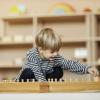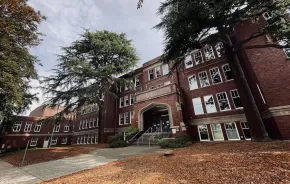Early on, my husband and I decided to make traveling with our kids a high priority. In fact, we ranked it right up there with "providing a good education" on the (pretend) "Important Things to Do as Parents" list.
We knew that taking trips with our children would be fun. What we didn't know is that it would be educational - especially the trips that exposed the kids to diverse cities, cultures, people and places. (That excludes our several jaunts to Disneyland, unless you consider Tinker Bell diverse.)
After several unfortunate - if not dangerous - journeys made with trains and automobiles, we settled on planes as the mode of transportation that worked best. That meant coming up with a solid strategic plan to make flying reasonably pleasant and possibly somewhat relaxing.
For us parents, not the kids. What we wanted for them was a smidgen of learning and productivity to accompany the bags of Jelly Bellies we'd typically (and somewhat desperately) provide.
So along with the Legos, the puzzles and the dot-to-dot pads, we'd carry children's books filled with photos and descriptions of our destinations. I'd pack games, crayons, Etch-a-Sketch and plenty of paper - and wrap everything individually so the kids could open "surprises" every hour of the voyage. (This, of course, was before 9/11, when you could tote a wrapped gift through security. If you try this today, leave the top of the wrapping open for inspection.) We also gave the kids journals, optimistically hoping they'd scribble, draw or write in them.
Pack plenty of props
The truth is, we improvised; there wasn't all that much out there in those days for travelin' tots.
Oh, how things have changed.
For starters, there's the portable DVD player. Those of you who are shuddering in horror at the prospect of plugging your child into Baby Einstein at 35,000 feet have clearly not attempted to fly with a small child lately.
These days, you're lugging the car seat and the stroller while stressing about the way you've packed the breast milk (see sidebar for current TSA rules) and wondering whether the stuffed teddy bear will clear security. A TSA agent once confiscated my 4-year-old granddaughter's Play-Doh; by the time we got through arguing with the agent, no one was happy, she had no Play-Doh and we nearly missed our flight.
So borrow or buy the DVDs and make sure you choose high-quality movies, such as Disney classics or, for young kids, LeapFrog learning programs.
On long flights, limit screen use and pull out the props. ParentMap national account manager Laura Glass packs a "secret activity bag" for her kids, each one filled with arts and crafts supplies. Special tip from Glass: Crayola makes a non-rolling crayon that won't disappear off the seat's tray table.
Glass, who travels extensively with her husband and kids Sophie (8), Henry (3) and Charlie (11 months), always takes books written in the language of the country the family is about to visit, along with books written for kids about the city's sights and traditions. "That way it's not a forced history lesson, and we get to plan some of the excursions we'll take once we're there," says Glass. "All of this creates buy-in from the kids and generates excitement."
To keep her 3-year-old occupied, Glass brings puzzles and activity books that include reusable stickers. She also takes magnetic storyboards. "They pack easily, are self-contained and you can create different stories with magnets," says Glass.
Sue Nevins, who sells children's books at the Elliott Bay Book Company in Seattle, is crazy for the Chicken Socks activity books by Klutz. One of her favorites, Totally Tape, is perfect for young flyers, she says. It comes with four roles of colorful paper tape and "tape me" pages; kids match shapes, create designs or "paint" the pictures in tape.
Nevins also suggests bringing CD recordings by storyteller Jim Weiss. Titles (check more out at Amazon.com) include Uncle Wiggly's Storybook, Animal Tales, and Adventures of Tom Sawyer.
Workbooks - Frank Schaffer publishes the best, says Nevins - attract preschoolers through third-graders, but only if they're the "right thickness," she says. "The kids roll their eyes when they see workbooks thicker than an inch."
Flying? This museum's for you
What other ways can you generate excitement about air travel while maximizing learning? If you live in the Seattle-Tacoma area, you're practically shouting distance from the ultimate destination for future fliers: The Museum of Flight. Located 10 minutes south of downtown Seattle, the museum features exhibits and programs for preschoolers on up, covering pretty much everything you ever wanted to know about aviation.
And if you're a kid about to go on an airplane, why not learn something about that incredible flying machine?
At the museum's Flight Zone exhibit, kids can enter small aircraft and experiment with aircraft instruments. They can get up close and personal with working models of engines and other aircraft materials, and wriggle into small aircraft. Preschoolers can play with airplane toys on a soft runway floor mural, and whiz by a miniature air traffic control tower. First-time fliers who want to see what the inside of an airplane looks like can inspect a Boeing 737.
"It's very hands-on," says Seth Margolis, the museum's director of education programs. "There are opportunities for plenty of interaction between parents and children."
The museum offers programs, weekend workshops and summer camps for kids; you can check them out at www.museumofflight.org.
Linda Morgan, ParentMap's associate editor, writes frequently on education issues.
BOX
What else should you take?
Tonyia Vining, head of the children's book department at the University Book Store in Bellevue offers these ideas:
The Rough Guide to Travel with Babies and Young Children by Fawzia Rasheed de Francisco. This book includes tips, resources and things to do that make travel easier. $15.99; Rough Guides.
Lonely Planet's Travel with Children by Cathy Lanigan. This book takes a look at things in different ways; the author offers pre-departure advice and explore the "Are we there yet?" factor. $14.99; Lonely Planet.
My First Things That Go. This is a board book of picture cards about travel and things that move, almost like a flash-card system. $5.99; DK Preschool.
Richard Scarry's A Day at the Airport. A lot goes on in this $3.99 book, which includes plenty of information about planes and airports. Random House.
Mad Libs. Still popular after all these years, they now have tie-ins with movies such as "Bee Movie." About $3.99; Price Stern Sloan.
Hidden Pictures Sticker Fun. These are new from Highlights magazine. $5.99; Boyds Mills Press.
Eeboo Magnetic Slides and Ladders. This is a magnetic travel game for ages 3 and older that comes in a travel bag and with wonderful art by well-known children's illustrators. $11.99.
BOX
TSA regulations re: baby formula and breast milk:
"When traveling with your infant or toddler, in the absence of suspicious activity or items, greater than 3 ounces of baby formula, breast milk, or juice are permitted through the security checkpoint in reasonable quantities for the duration of your itinerary, if you perform the following:
1. Separate these items from the liquids, gels, and aerosols in your quart-size and zip-top bag.
2. Declare you have the items to one of our security officers at the security checkpoint.
3. Present these items for additional inspection once reaching the X-ray. These items are subject to additional screening.
You are encouraged to travel with only as much formula, breast milk, or juice in your carry-on needed to reach your destination."
(Source: Transportation Security Administration)









